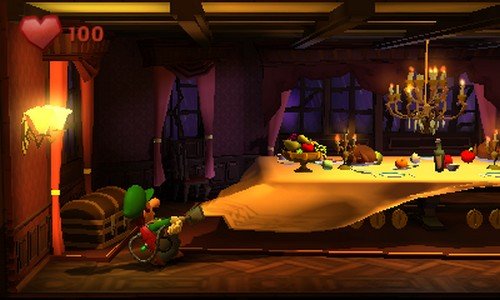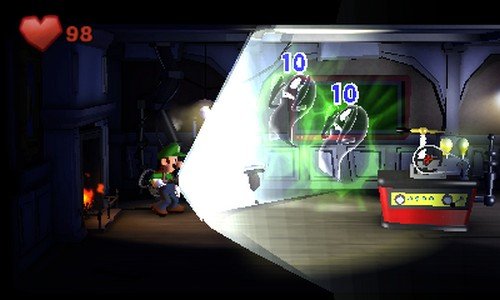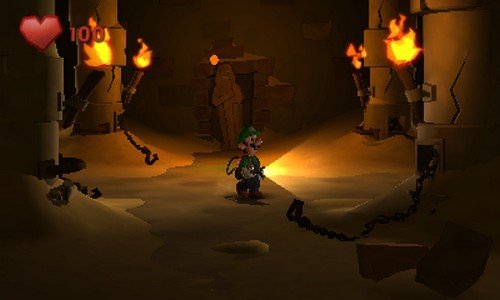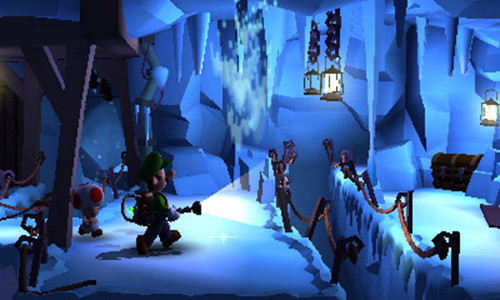Game Review
by Dave Riley,Luigi's Mansion: Dark Moon
Nintendo 3DS
| Description: | 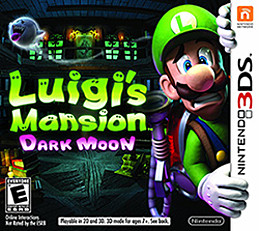 |
||
Dark Moon is Luigi's second ghost hunting expedition and one of the rare times he's allowed to leap out from his brother Mario's shadow. Horror has returned to the mansion, and Luigi and his Poltergust 5000 are the only ones that can stop it. |
|||
| Review: | |||
It's difficult to disassociate the original Luigi's Mansion from the pall it cast over the Gamecube's launch. Mario 64 blew the doors off of the Nintendo 64's release, so everyone was primed for another smash platforming sensation. Literally every Nintendo console pre-Gamecube debuted with a Mario game. We were ready for another upbeat, jumpy, cheery platformer and instead we got this game about hunting ghosts with a vacuum cleaner, The Poltergust 3000, that was quirky, kind of funny, and kind of cool, but definitely wasn't what we expected, and we all hated it for that. All anyone could ask was: where's Mario? Turns out he was waiting at the end of the game. The sequel, Luigi's Mansion: Dark Moon, has a slightly easier road to hoe. The 3DS already has its standard Mario in New Super Mario Bros. 2 (co-starring Luigi, in the co-op), so Luigi's second outing can sink or swim on its own merits without the fearful spectre of angry fans who haven't had their fill of sidescrolling and koopa shells.
Reunited with Professor E. Gadd and his Poltergust (upgraded to the 5000 series), Luigi begins in a familiar haunted house setting. He zaps spiders with his flashlight, dodges animated suits of armor, and captures relatively benign trickster ghosts. After he's recovered all his tools (which now include the illusion-breaking Dark Flashlight) the hunt progresses from the mansion to the dusty clock tower and the snowy crystal mines. The locales have changed, but the mechanics are the same. Most of the game is about solving puzzles, and almost all of them are solved by vacuuming up a tapestry or shining the flashlight on a light-activated switch. Sometimes the tapestry is a yanked-out carpet that knocks over a knight, sometimes the light-activated switch is a mobile bomb that blows up a wall, but Luigi's methods of interaction with the world are mostly limited to "suck" or "glow." The simplicity works in Dark Moon's favor. Puzzles -- such as burning spider webs to free keys or blowing on a fan open a hidden passage -- are almost all in self-contained rooms, but almost every single room is a puzzle, and they're completed in such rapid succession that a sense of accomplishment builds and builds and builds until a level's final puzzle is solved and the stage ends with an actual shower of confetti. And between the puzzles there are ghosts who wreak G-rated mischief until they are stunned with the flashlight and constrained by the Poltergust. There are green ghosts and blue ghosts and big, muscly red ghosts. Some ghosts wear sunglasses, so you can't stun them until you pull them off. Some ghosts have shields or swords, so you can only stun them after they've whiffed an attack. Some ghosts are stronger, or have more hit points, so you have to deliver big damage via tug-of-war: Luigi charges a power bar by moving in the opposite direction of the ghost and the player unleashes a mega-hit by tapping the A button when the bar is full. The act is remarkably tactile: escaping ghosts have to be counteracted with aggressive pulls of the analog nub. Larger spirits will drag Luigi all about the room. Their erratic motions force constant shifts in direction until it's hard to keep a good hold on the stick. Often, your knuckles begin to ache as the power bar is millimeters from a full charge, but you are only fractions of a second away from a successful capture, if you can only hang on...
Failure is infrequent: the difficulty is pretty ho-hum until a late game spike of advanced ghosts, significantly more difficult bosses, and a pain-in-the-butt mission on a time limit. The enemies progress faster than upgrades to Luigi's equipment can really keep up, so the end-game specters feel a skotch more difficult than they ought to be. There are plenty of times in Dark Moon where you execute a skillful maneuver, snare three ghosts at once, and feel like a champion. There are also plenty of times when you're struggling to do appreciable damage to even one ghost, flailing awkwardly around the room while one or two others are hide in nearby furniture and pelt you with banana peels. There are plenty of times when Luigi takes damage from dragging around a ghost too long because it's never quite clear what direction on the analog stick is definitively "opposite" from where the ghost is trying to go. There are plenty of times when the Uncharted/Sixaxis-era tilt controls hurl Luigi off of a balance beam and into a bottomless gorge, over, and over, and over, because this is a portable game and you're playing it on a subway. These sticking points are exacerbated by the lack of mid-mission checkpoints. Each death leads to a progressively more disgruntled player, because each death means cutscenes to skip and already-solved puzzles to realign. There is the occasional 1UP, but these seem to be distributed at random and can't really be relied on, especially during boss levels.
A multiplayer variant exists, with players taking the role of Luigis of various colors as they fight through a puzzle-light version set in a randomly generated dungeon called the Scarescraper. Dark Moon is one of the rare games that supports the critically underused download play, so multiple 3DSes in the same household or at convention gatherings can play together using only one copy. Friends can capture ghosts or track down evasive spectral puppies together, and the frantic, fun bobbling about of singleplayer ghost-snaring remains just as frantic when it's multiple players locked onto one giant boss. But ghost-nabbing is only half of the equation. Without much in the way of puzzles, and with its strict focus on time limits, Scarescraper feels a bit anemic. The game has its appeal. There's a definite charm to Luigi's comically overblown cowardice and to the ne'er-do-well ghosts, who are too capricious to be thought of as ghastly, and who rattle armoires more often than they trail blood down the walls. There are a handful of intense moments where victory is snatched from the jaws of defeat, and there are a (slightly smaller) handful of frustrating moments where you just plain get defeated and have to start the level over. The first major boss, a giant, armored spider, requires the use of every skill learned up to that point. It keeps you busy by forcing you to use the flashlight, the vacuum, and every item in the environment to win. It is as thrilling as any boss battle involving a vacuum has any right to be. By comparison, the fourth major boss is a snoozefest on-rails turret sequence. From the outset Dark Moon gives the impression that it is something like a Metroid game, where Luigi acquires more tools to deal with different obstacles and proceed to different parts of the mansion. It is actually less Metroid and more a point and click adventure, only without an inventory of knick-knacks weighing you down. There is a satisfying feeling of completion that comes with pushing and pulling and poking everything in the environment, hoping for a cascade of coins or a secret swivel door or a hidden Boo. But the pattern becomes too predictable. It falls back on its own tricks frequently and without apology. You trail encounter one government-regulated "save the Toad" mission and one government-regulated "get the key from the ghost dog" mission per world. The third time you have to escort a Toad to safety is just a hair away from to one time too many.
Really what's keeping you going is that sucking up ghosts never gets dull, and that hammering out puzzle after puzzle provides bite-sized portions of accomplishment that vaguely satisfy, but keep you hungry for more, each solution gives just enough of an endorphin rush to whet your appetite for the next challenge. There is a geegaw whose pieces you have to collect to solve the plot. There is a nominal big bad guy, but he doesn't show up much. You quest from area to area not for much of a reason, but because poking barrels with the vacuum cleaner remains entertaining throughout, and because the ice area's puzzles are slightly different than the mansion area's, and so on. What starts out as a thrilling ghost romp never becomes boring, but it does lose a bit of its steam as time goes on. It is an above average game, definitely, and it has its share of strengths. It is very, very pretty. Its graphics are far crisper than the 3DS average and its locales are designed like intricate theatre sets or living shoebox houses. It has an adorable, bassy, "spoooooky!" soundtrack. In many ways, like with that spider boss fight, it is excellent, and its rugged pursuit of simplicity keeps it grounded, makes it difficult for us to get angry at it, even in the moments where it fumbles. But still, it unravels, a bit, as it goes on, poking and prodding at the player's patience until the thrill of the first half is diluted by the what-could-have-been of the last third. It's not a traditional, straight-faced Mario platformer. It's nothing like that, and we should appreciate the diversity that games like Luigi's Mansion bring to a Nintendo canon stuffed to the gills with mostly-samey Mario platformers and Zelda adventures. At the same time we should be careful not to immediately interpret "diverse" or "different" as "outstanding" or "brilliant" just because it doesn't directly involve stomping on goombas. |
|
The views and opinions expressed in this article are solely those of the author(s) and do not necessarily represent the views of Anime News Network, its employees, owners, or sponsors.
|
| Grade: | |||
Overall : B
Graphics : A-
Sound/Music : B+
Gameplay : B
Presentation : B+
+ Excudes charm in its characterization, set design, and atmosphere. Reeling in ghosts can be intense, at times. |
|||
| discuss this in the forum (5 posts) | | |||
